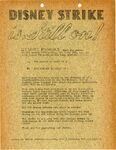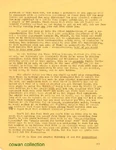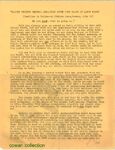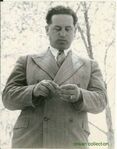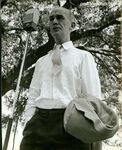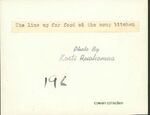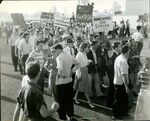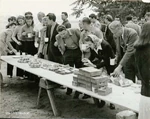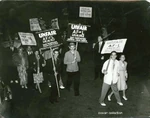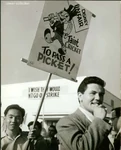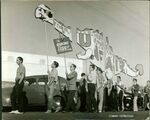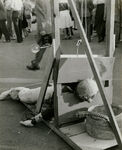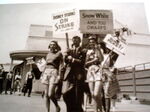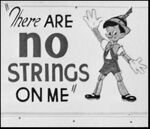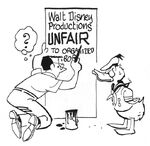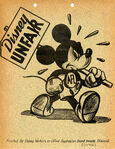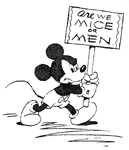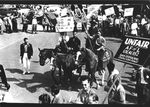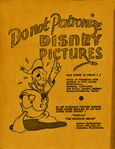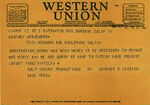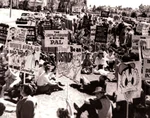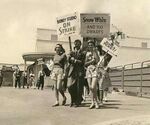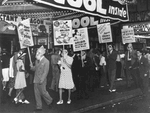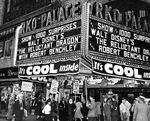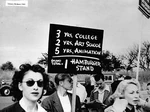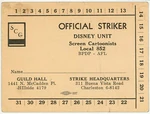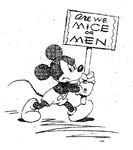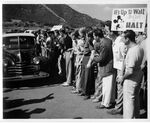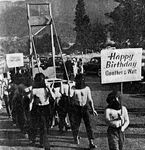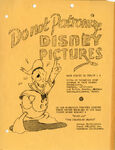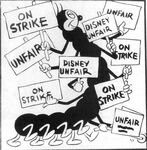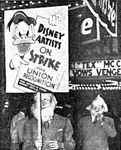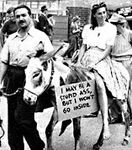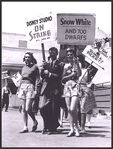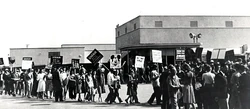
The Disney animators' strike was a labor strike by the animators of Walt Disney Productions in 1941.
History
The 1930s led to a rise of labor unions in motion pictures as in other industries such as the Screen Actors Guild, which was formed in 1933. Animators of Fleischer Studios went on strike in 1937 when Max Fleischer fired 15 employees, all of whom were a part of American Art-Union. The Fleischer strike was eventually solved by forming the Screen Cartoonists Guild in 1938. The leader of the Guild was Herbert Sorrell, who was described as a "tough left-winger". Sorrell began a push and obtained contracts with Terrytoons, Walter Lantz Productions, Screen Gems, George Pal, and MGM. Leon Schlesinger, whose Leon Schlesinger Productions produced the popular Looney Tunes/Merrie Melodies cartoons for Warner Bros., attempted a lockout, but soon gave in to the union and then asked, "What about Disney?"
Although Disney artists were the best paid and worked under the best conditions in the industry, there was discontent. In the early days of the studio, Walt Disney gave 20% of the profits of the short cartoons to his employees as bonuses. However, Disney suspended this on the film Snow White, because although many of the employees had given Disney large quantities of free overtime during the drive to complete Snow White, many critics felt Snow White would be a huge flop and the film was unlikely to make any money. Ironically, Snow White was an enormous success, but Walt had previously read a book on psychology, so instead of giving out bonuses to everyone he gave out "salary adjustments" to certain animators who he felt did exceptional work. Those who he felt didn't live up to his expectations got nothing, but said if they improved, they would get bonuses on his next film. However, in doing so, he had brought a number of workers up over the forty-dollar-a-week level, at which point, under the Wagner Labor Relations Act, the higher paid employees ceased being entitled to time-and-a-half for overtime.
Unfortunately, World War II cut off 40% of Disney's foreign release market, which led Disney's two following films: Pinocchio and Fantasia to fail at the box office. In return, Disney could no longer afford to give the workers their bonuses, and Walt was forced to take salary cuts. By this time these so-called "salary adjustments" had caused the pay structure at the Disney studio to become very disorganized. Many of the animators joined the Screen Cartoonists Guild, including Art Babbitt, who became one of the union leaders. Babbit then started questioning Walt's authority and "rallying his staff against him" in Walt's words.
As the biggest and most successful animation studio, Disney was an obvious target for the Screen Cartoonists' Guild. Sorrell approached Walt and demanded that he sign a salary agreement with the Guild and threatened to go on strike if he refused. Walt said that he should put it to vote with the National Labor Relations Board. Sorrel had lost an election before and demanded Disney sign with the union. Disney again stated he would put it to a vote. Sorrell claimed that Disney was a fool and he was going to "crush Disney to a dustbowl".
The final spark that started the strike was when Disney fired Babbit who he regarded as a "troublemaker" and a "Bolshevik". The next day on May 28, 1941, the strike began, instigated by Sorrell and led by Babbitt.
The strike occurred during the making of the animated feature Dumbo, and a number of strikers are caricatured in the feature as clowns who go to "hit the big boss for a raise".
During the strike, cartoonists from other studios offered support for the strikers. Cartoonists from Warner Bros., including Chuck Jones, volunteered their cars to form a motorcade around the Disney studio.
At one point, one morning early on in the strike, Babbitt was on the picket line when he noticed Walt driving his car through the picket line and casually waving to the strikers. Offended by his boss' nonchalance, Babbitt, holding up a bullhorn, announced to the strikers the arrival of "the man who believes in brotherhood for everybody but himself." The crowd booed their boss, who became so enraged that he abruptly stopped his car, got out, and advanced on Babbitt with his hands balled into fists, only to be intercepted by the police.
The strike lasted five weeks. Toward the end, Disney accepted a suggestion by Nelson Rockefeller, then head of the Latin American Affairs office in the State department, that he make a tour of Latin America as a goodwill ambassador. His removal from the scene enabled passions to cool, and in his absence the strike was settled with the help of a federal mediator, who found in the Guild's favor on every issue. The Disney studio signed a contract and has been a union shop ever since.
Gallery
Aftermath and notable departures
Following the strike, irreparable damage to the psychology and mood of the studio had, nevertheless, been done. Before the strike, the number of employees had been about 1,200, but after it ended, it was reduced to 694. Schickel quotes a letter in which Disney said that "it cleaned house at our studio" and got rid of "the chip-on-the-shoulder boys and the world-owes-me-a-living lads".
In addition to Babbitt, among the notable animators that left following the strike were Bill Tytla, Walt Kelly, and Virgil Partch. The departures also included David Hilberman and John Hubley, who all went on to form a new animation studio known as United Productions of America, or UPA. Leaving for the MGM studio were Kenneth Muse, Ray Patterson (he briefly worked at Screen Gems for a year under Tashlin's supervision before going to MGM), Preston Blair, Ed Love, Walter Clinton, and Grant Simmons. Animators who would resurface at Leon Schlesinger Productions (then under contract to produce cartoons for Warner Brothers) included Bill Meléndez, Frank Tashlin (who had worked at Schlesinger before moving to Disney), Emery Hawkins, Basil Davidovich, Maurice Noble, Cornett Wood, Ted Bonnicksen, and Jack Bradbury (Hawkins, Davidovich, and Bradbury would return many years later).
Other notable animators to leave following the strike included Volus Jones, Claude Smith, Bernie Wolf, Joey Lockwood, Alfred Abranz, William Hurtz, T. Hee, and Howard Swift. An unfair labor practices suit brought by Babbitt (by this point drafted into the Armed Forces) worked its way through the courts, and Disney was forced to rehire him after World War II. But Disney, who had blamed Babbitt for instigating the strike, never forgave him for what he had done. Babbitt finally left Disney for good and on his own free will in 1947.
Several of the other people who left Disney after the strike returned in the postwar years, including Volus Jones, Phil Duncan, Milt Schaffer, and (briefly) Emery Hawkins. Basil Davidovich returned in the 1950s. Jack Bradbury became a frequent artist for the Disney comic books beginning in the 1950s.
The strike also had an impact on Walt Disney. Before the strike he (and the other employees) felt as if they were "one big family", but during and after the strike Walt felt betrayed and he was not sure whether he could trust anyone. Walt eventually recovered for the most part but never quite forgave the people who had been part of the strike.
External links
- The Disney strike, from Cartoonists' Unions: A survey of our history
- Another look back at the 1941 Disney Studio strike; includes contemporary article from Screen Actor magazine

